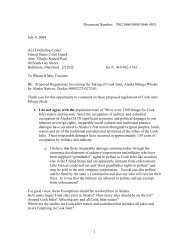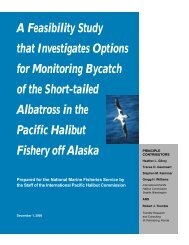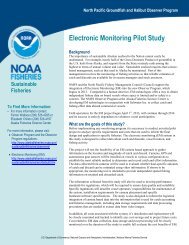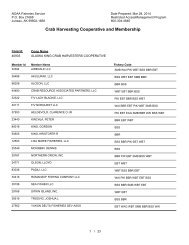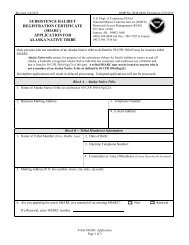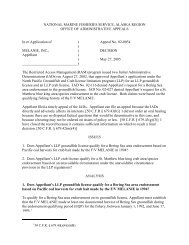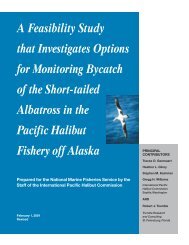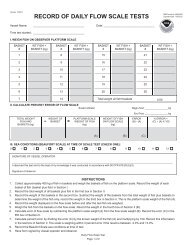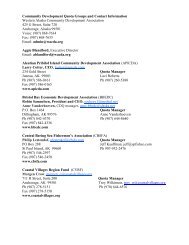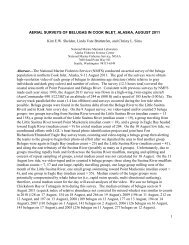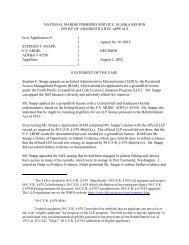Petition to List Lynn Canal Pacific Herring under the Endangered ...
Petition to List Lynn Canal Pacific Herring under the Endangered ...
Petition to List Lynn Canal Pacific Herring under the Endangered ...
You also want an ePaper? Increase the reach of your titles
YUMPU automatically turns print PDFs into web optimized ePapers that Google loves.
larval developmental success are, for example, reduced at both low and high<br />
salinity levels in <strong>Pacific</strong> herring, C. pallasi, and this species’ optimal salinity<br />
range was found <strong>to</strong> be higher than that of Baltic herring (Griffin et al. 1998).<br />
(Bekkevold et al. 2005). Griffin et al. (1998) determined that individual populations of<br />
<strong>Pacific</strong> <strong>Herring</strong> have differing <strong>to</strong>lerances salinity levels with regard <strong>to</strong> fertilization and<br />
reproduction.<br />
Although we do not believe that salinity is <strong>the</strong> only fac<strong>to</strong>r governing successful<br />
reproduction of <strong>Pacific</strong> herring, it does appear <strong>to</strong> be an important component of<br />
both fertilization and embryonic development. Fur<strong>the</strong>rmore, comparisons of<br />
fertilization in <strong>the</strong> San Francisco Bay population with that of a Baltic population<br />
of C. h. membras and with published reports of o<strong>the</strong>r <strong>Pacific</strong> herring populations<br />
suggest that salinity <strong>to</strong>lerance ranges may differ between populations. The effects<br />
of salinity pressure on development may be more subtle than those on<br />
fertilization, yet may have more impact on recruitment in <strong>the</strong> environment.<br />
Altered salinity not only reduces <strong>the</strong> number of normal, competent larvae that<br />
hatch, it also delays <strong>the</strong> hatching of those embryos. The costs of such delays,<br />
separations from larval schools, depleted energy reserves, and extended time in<br />
chorion (where embryos are subject <strong>to</strong> both predation and exposure) influence<br />
chance for survival.<br />
(Griffin et al. 1998).<br />
F. The “Best Available Science” concerning <strong>the</strong> DPS<br />
inquiry<br />
While discussing what should make up “Designatable Units” of a species for<br />
conservation purposes, Green et al. (2005) emphasized that <strong>the</strong> geographical location is<br />
of paramount importance. While genetics are a useful <strong>to</strong>ol, Green et al. (2005) stressed<br />
that an overemphasis on genetic distinctions should be avoided.<br />
[O]ccupation of differing biogeographic regions by a species reflects <strong>the</strong> probable<br />
existence of his<strong>to</strong>rical or genetic distinctions and adaptations in each of those<br />
regions even though <strong>the</strong> range may appear <strong>to</strong> be continuous.<br />
(Green et al. 2005)(emphasis added). Green et al. (2005) fur<strong>the</strong>r argues that:<br />
Designatable units based on <strong>the</strong> different biogeographic zones <strong>the</strong> species<br />
occupies are <strong>the</strong> most defensible and prudent means <strong>to</strong> adequately describe its<br />
overall conservation status (Schock 2001).<br />
Evolutionary patterns <strong>the</strong>refore are not <strong>the</strong> focus, and <strong>the</strong> methodology does not<br />
rely on a priori systematics. The use of [Designatable Units] might be criticized<br />
for recognizing “nonevolutionary” units or for not paying strict attention <strong>to</strong> <strong>the</strong><br />
38



